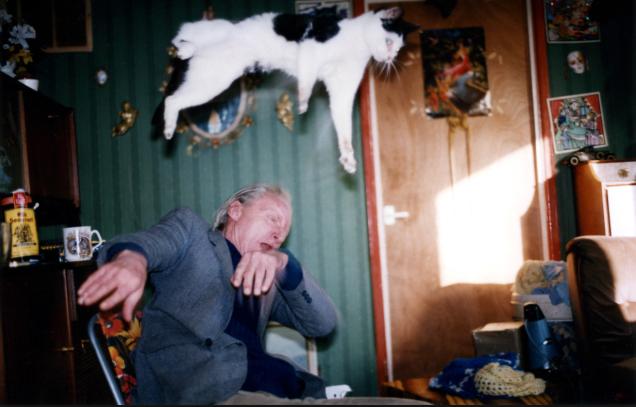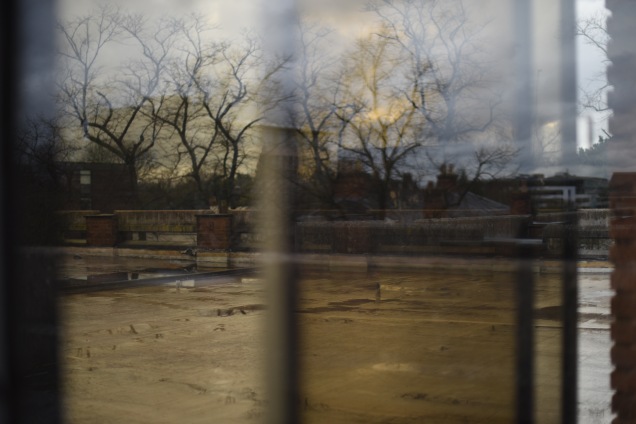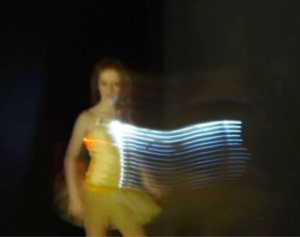Informing Contexts : Falmouth University MA
We were invited to review the work of Richard Billingham and reflect on any relationship to our own practice.

Sampling the moving and static images of Billingham’s early domestic work renders me uneasy, cautious in how to express my feelings about it because of an innate middle-class, left leaning consciousness about appearing or indeed being patronising or condescending or despairing or in a way fond of the people I mix with where I walk my dog Rory every week where the Black Country overlaps with the city of Birmingham. But I realise that is because Billingham actually gets in there, he was in there, part of it, growing up, watching, capturing and apparently unselfconsciously making a series of images that were it; the life that threw his whole family into a claustrophobic box after selling to a con man the terraced home that had a street, back yard and neighbours. He has produced a view literally from the inside, images that always beg questions; the flight of the cat, the smear of flies, the escapism of huge jigsaws and fags (death at 56) and perpetual alcohol (death at 74). It is an incredibly consistent body of work, a micro familial study, nowhere are the Ektachrome images of capital cities, smiling faces and beaches that constitute most family slide collections.
Emerging from his foundation course locally and his degree in Sunderland Billingham got noticed and his observations of the ordinary at the 2000 exhibition at Ikon Gallery, Birmingham carry the connotations in their titles of his approach to home and photography; family portraits (1990-1996), earlier black-and-white family photographs (1990-1991), a new series of urban landscapes (1992-1997) as well as video stills and four short video pieces: Ray in Bed (1999), Playstation (1999), Liz Smoking (1998) and Tony Smoking Backwards (1998). https://ikon-gallery.org/event/richard-billingham/ (accessed 2 April 2017). Having gazed at Billingham’s images I see an aesthetic that is cramming in the colour, yet poverty, desperation yet a homily to home, clashes of pattern, clashes of flies dying in the kitchen, clashes of people, clashes of need. They are there, they are in your face. He chose to make images perhaps to understand, perhaps to make a memory, perhaps he “sought a more critical understanding of the reality of his daily life” to quote Cotton in Ray’s a Laugh .
To gaze at the images one pleads to know more more; why, how, who? No one knows if a film will be good until the critics write and the cinema audience grows. Similarly Billingham didn’t know this series would pluck him from the pack and make famous not just him but those to whom he would be tied for ever through birth. I am certain this drew out his protective stance towards his subjects when the gaze was not just an audience in a gallery, but the gallery was Tate Britain’s Turner and the press and media always thrive on the Tate’s ability to promote and provoke. The biographic photographer’s eye was fixated on his own, his nearest and thus he naturally sought, as a reaction to the interest, to the media gaze to protect them. I would too.
At the Kunstmuseum exhibition Ich, zweifellos, Wolfsburg, 2009-2010 http://www.photography-now.com/exhibition/63156 (accessed 2 April 2017) Billingham was shown alongside some established big names Cindy Sherman, Bruce Nauman and Beat Streuli. The show’s theme translates as Undeniably Me. There could be no better way of embracing Billingham’s work under that banner.
In another show, entitled Damaged Romantics, https://greyartgallery.nyu.edu/exhibition/damaged-romantic-011309-04409/ (accessed 2 April 2017) we perhaps peel away at some of Billingham’s thinking in an interview, “Observing viewers’ reactions to these early works, Billingham commented, “I quickly came to realise that most people only saw the surface of the images,” adding “I don’t think most people saw the beauty underneath or how well the pictures were composed.”
In an interview with Tim Adams in March 2016 we get more insight and a reminder about managing viewers; the gallery and the context of the web https://www.theguardian.com/artanddesign/2016/mar/13/richard-billingham-tower-block-white-dee-rays-a-laugh-liz (accessed 2 April 2017) We talk about the line between exploitation and documentary; did Billingham worry about crossing it when he photographed his family? “Not really. That’s why you put them in a gallery,” he says. “You frame them in a certain way to allow a particular reading of them. But now you have the internet, the pictures are all there out of context…” Does that bother him? “With the photographs I tried to make them as truthful as I could and hopefully that element overcomes any exploitative element,” he says. “I think there was a warmth to them.” The interview goes on to lay before us the explicit reality, should we be under any misconception about the actuality of living in that tower block “But there was a weakness there in Ray and Liz that he must have hated, when his brother was taken into care and so on? “No,” he says. “A vulnerability. I just hated growing up in that tower block. I didn’t like being unable to walk out of the door. You had to get in the lift and people would piss and shit in the lift and spit on the walls. You had to be careful never to lean on anything.””
I agree with the statement, “Where can something so tragic be at once so aesthetically magnificent? Where can hopelessness, failure and darkness be propped up to enjoy so voraciously… only in art” http://www.telegraph.co.uk/culture/4726608/Meet-the-parents.html (Links to an external site.) (accessed 2 April 2017). The series of images are made to show not just a method of practice focused on reality, but to convey the real, a kind of naked frankness that is enthralling and embraces an idea through the convenient means, the camera. They are moments which most certainly strike on viewing, for which Barthes can be applied “This second element which will disturb the studium I shall therefore call punctum; for punctum is also: sting, speck, cut, little hole – and also the cast of the dice. A photograph’s punctum is that accident which pricks me (but also bruises me, is poignant to me). BARTHES, R. (1981). Camera Lucida: reflections on photography. New York, Hill and Wang. (pp26-27).
Billingham’s work has now progressed and such shows as this in Eastbourne in 2015
http://www.townereastbourne.org.uk/exhibition/richard-billingham-panoramic/ (accessed 2 April 2017) exhibit his quite intense panoramic landscapes.
Then there is the transition to seek funding for a film through a Kickstarter campaign https://www.kickstarter.com/projects/68852125/ray-and-liz, so Billingham has managed to find a line between protection and publicity through the explanation of a film.
Reflecting on my own practice I see two strands to Billingham’s work, the brutal conveyance of his human circle which in many ways could not be further than my own work (except perhaps for the brutality of demolishing thoughtful, fine and robust structures from the Twentieth Century and casting them to dust to make way for the wealth making machinery) but the study of the ordinary, of things as they are found, the things that are close by, that may not be pretty, may lack a traditional deliciousness, really chimes with me. I caress concrete as though it is skin, to find lines, pores, smoothness and invite my camera to do the same. The aesthetic of the banal is easily overlooked, but in Billingham’s case, not.






